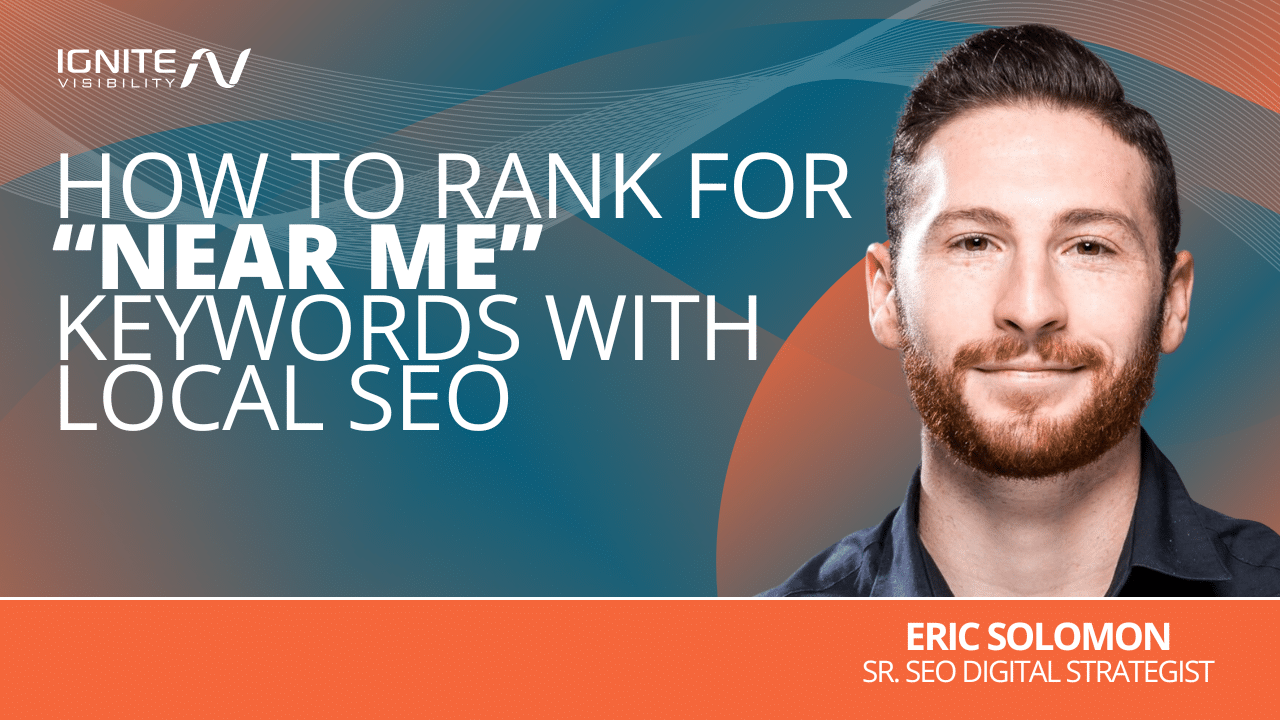
Today, around 8 in 10 consumers search for local businesses online at least once every week. Those searchers often contain the “near me” tag as searchers seek solutions nearby. In fact, according to recent statistics from Google, “open now near me” searches see a 400% year-over-year increase. These keywords are particularly valuable because of their high purchase intent, as people entering these terms tend to be toward the end of the customer journey.
In this blog, Eric Solomon, Sr. SEO Digital Strategist, will review key local SEO “near me” strategies, including building a Google Business Profile for each location, on-page SEO tactics, user-generated content, link building, and more, illustrating precisely how to rank for the words “near me” and much more.
What You’ll Learn
- What You Need to Know About “Near Me” Searches
- How to Rank for Local SEO “Near Me” Searches in 4 Steps
- “Near Me” Terms for Franchise and Multi-Location Businesses
- AI and Local SEO: The Future of Search
- FAQs About Local SEO “Near Me” Searches
My Expert Insights on Local SEO “Near Me” Searches,
Local searches are the biggest driver of traffic. Those searching often have higher purchase intent when they add ‘near me.’ Using these two words has grown in the past few years as buyers seek convenient, local solutions.
This SEO subset is unique, as it translates digital research into physical foot traffic or direct calls to service providers. Any local business should include local SEO “near me” as a pillar of their content strategy. When businesses optimize for this, they can expect a significant return on their investment.
As Google continuously refines its algorithm to deliver more relevant results for users, they have evolved the descriptor, now treating “near me” as a proximity indicator versus an exact keyword match. Capitalizing on this search trend requires a variety of optimization tactics. When executed effectively, local companies can improve their visibility in search rankings to get attention and clicks from audiences in their backyard.
Also, as of January 2025, Google’s local ranking algorithm has undergone even more updates to optimize results. Specifically, to optimize for local SEO “near me” terms, you’ll need to maintain a consistent Name, Address, and Phone Number (NAP) on all local directories and platforms. Customer reviews and ratings are also of utmost importance, and enhanced AI integration can further understand user intent to more precisely target keywords.

What You Need to Know About “Near Me” Searches
In local SEO, “near me” keywords are those that show up for local businesses in people’s areas, such as “home renovation services near me” or “ice cream shop near me.”
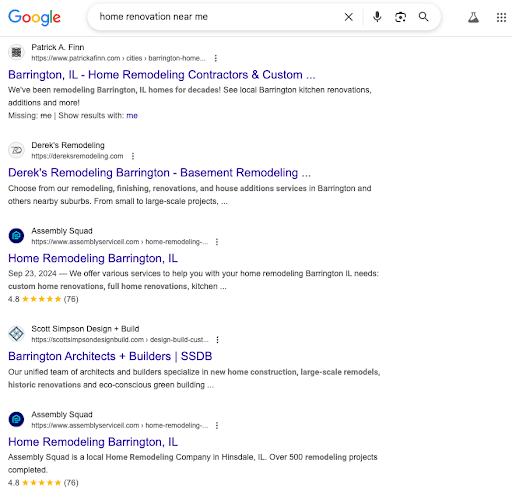
“Near me” SEO allows businesses to get in front of people at the decision phase of the customer journey. They are critical for local companies with a physical location and interface with customers.
Generally, you’ll benefit from local SEO “near me” optimization if you own any type of business with a brick-and-mortar location that customers will visit or services that you provide to people within a certain service area. A few examples include retail, restaurants, entertainment, hotels, spas, and field service companies like HVAC, plumbers, or electricians. These organizations all target audiences that are nearby.
One of the main advantages of knowing how to rank for “near me” keywords is the ability to connect with people who are most likely to make a purchase. People at this transactional stage of the buyer’s journey, who likely started at the informational stage toward the top of the funnel, will be more eager to convert based on their search intent.
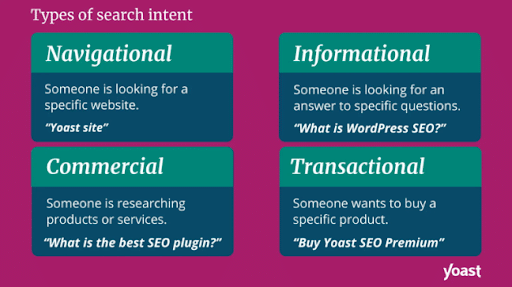
People will also be highly likely to use their mobile devices to conduct these searches, with mobile “near me” searches seeing a 136% year-over-year growth. Mobile-first optimization is essential in appealing to these audiences, and targeting the right “near me” SEO terms can make all the difference.
So, how do local SEO “near me” searches work? Google “near me” searches interpret the phrase as about proximity, not a keyword match. They are often very specific, signifying a micro-moment for buyers needing your product or service.
To rank for the words “near me” in your content, you’ll target specific locations with everything from city-specific search terms to unique business information for each location.
Just about any local business can use these strategies:
- Home Services: Remodelers, plumbers, electricians, landscapers, and more
- Automotive: Mechanics, auto body shops, car dealerships, and rental services.
- Hospitality: Motels, hotels, resorts, and villas.
- Financial Services: Businesses such as financial advisory companies and banks.
- Retail Stores: Nearly any type of retail location, including grocery stores, electronics outlets, and clothing stores.
- Food and Beverage: Diners, restaurants, bars, and breweries.
- Healthcare and Dental Offices: Everything from doctors and dental offices to hospitals and urgent care centers.
- Insurance: If your insurance company owns multiple offices
There are many SEO “near me” terms to give you an idea of how to rank website proximity all over a city, with some examples such as:
- Home Services: Electrician near me, plumber near me, home remodeling near me, pest control near me
- Automotive: Gas station near me, car rental near me, auto body repair shop near me, best mechanic near me, car dealership near me
- Food and Beverage: Restaurant open now near me, food delivery near me, food near me now, diner near me
- Hospitality: Hotel near me tonight, resort near me, best motel near me
Optimizing local SEO for “near me” terms like these could mean the difference between good overall performance and a severe lack of business.
So, how does Google decide who gets the top organic spot?
Google’s Three Ranking Factors
Google uses three criteria to determine local ranking:
- Relevance: The search engine assesses how well a local Business Profile matches a request. To optimize this, ensure your business information is completed, detailed, and accurate. Relevant local keywords can also help your Business Profile rank better.
- Distance: This component considers how far the search result is from the location term in the query. With “near me,” users don’t specify a location like a city or ZIP code. Google calculates the distance based on what they know about your location.
- Prominence: This refers to how well-known a business is in the offline world. Google also uses information about a business in the digital landscape, from web links to articles to directories. Google will also figure in things like review counts and scores. Be sure to include your business’s name, address, and phone number (NAP) all over the internet to stay prominent, and encourage social media shares among your audience.
Why Do SEO “Near Me” Searches Matter?
The data behind these local search options illustrate its importance. Google relayed that searches for “shopping near me” on Google Maps alone increased by over 100% in 2022. It’s a trend with staying power. Since users add it more often these days and its connection to buying intent, you can win the SERP (search engine results page) competition.
Local search offers higher engagement and ROI than others, according to Milestone Research. It owns a 22% session share, more than referral, organic, and paid search.
By continuing to optimize for “near me” searches, you’re creating a direct link from Google to your front door.
The Rise of Conversational Search in Local SEO Strategy
With the development and increasing popularity of voice search and AI assistants, it’s important to know how to rank for “near me” keywords using more conversational language.
More people are using their mobile devices, AI-driven search tools, Amazon Alexa, and other platforms to conduct voice searches that are notably different from traditional text searches. Because of this, you’ll want to target more conversational queries while further ensuring your Google Business Profile and other listings are complete and up to date.
Proximity and the Role of Geofencing and Geotargeting
Through the use of technology like geofencing along with geotargeted SEO campaigns, you can increase relevance and prominence in your area with your local SEO strategy.
This aspect makes it important to know how to rank a website’s proximity all over a city, maximizing your business’s visibility in various target locations.
For instance, you could set up a specific geofence to send targeted messaging to users within a particular area, while locally optimized landing pages use local SEO “near me” keywords to reach people in certain cities.
The more relevant and prominent your business is within a particular area, the more likely you will be to show up for people looking for businesses like yours.
Google Local Search Optimization: The Foundation for Local SEO Success
One of the primary components of any local SEO strategy is a business’s Google Business Profile (GBP), formerly known as Google My Business.
If you’re wondering how to rank a website’s proximity all over a city, all of the information on your GBP profile is integral to Google local search optimization.
In perfecting your profile, you’ll want to incorporate the following:
- Consistent Name, Address, and Phone Number, or NAP, which should be the same on your GBP and all other local listings, from Yelp to BrightLocal
- Google Business categories that are appropriate based on your product or service offerings
- Customer reviews and ratings that build trust and help with rankings
- Detailed descriptions
- Listed products
- Business hours
So, if you want to know how to rank for the words “near me” and other local terms, this profile is essential.
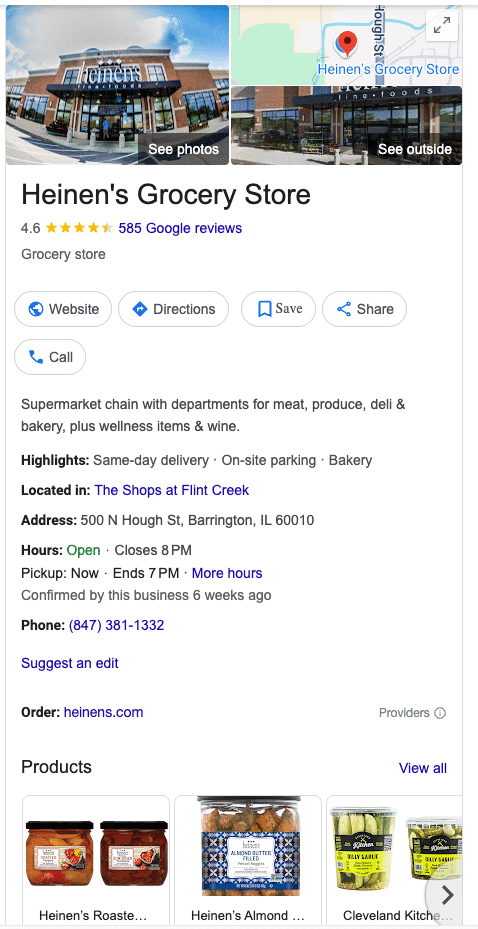
How to Rank for Local SEO “Near Me” Searches in 4 Main Steps
Wondering “how to get my website on Google Search for ‘near me’ terms?” Here are some steps on how to rank for the words “near me” along with other locally relevant search queries in your area.
Step 1: Claim & Complete Your Google Business Profile
Your Google Business Profile is one of the ways Google decides who gets top billing for “near me” searches. According to data from Statista, 77% of consumers use Google when looking for local businesses. This means potential customers are submitting queries right now to find you.
So, complete your signup for your Business Profile, share photos, videos, and social media posts, and get more customers to leave reviews on it to increase SEO “near me” rankings.
Local businesses can seize unique opportunities by creating engaging content in the form of high-quality photo albums showcasing their premises, team, and customer events.
By using tools to create photo albums online, such as personalized photobook services, it becomes easier for businesses to compile and organize these visuals beautifully
Once you’ve created your Google Business Profile and begin posting on it, it’s time to start collecting reviews.
Hearing directly from actual customers can greatly influence buyers when searching for local businesses. The majority of consumers (64%) said they are likely to do this on Google, per a ReviewTrackers report. Additionally, Google is the leading online review spot, with a 73% share.
While you may collect reviews on many channels, directing people to do so on Google can have the greatest impact. Google makes it easy for customers to write a review. Instructing customers to do this after they complete a purchase should be part of your customer lifecycle plan.
Not all reviews will be positive. Responding to these and the positive ones could improve local search rankings. It also gives context and demonstrates the humanness of your brand.
Optimize Your Google Business Profile Listing
Long after you’ve created your GBP profile, you’ll want to continually optimize it for peak performance. Google local search optimization will help you keep your profile on top and ensure you remain competitive as new local businesses attempt to steal your spotlight.
As needed, update your NAP, description, images, and other information. It also helps to make Google Posts that can appear on your profile and further help keep you relevant and prominent.
Also, take advantage of features like the Q&A section to answer any questions that potential customers might have.

Don’t neglect to include a product or service menu to detail precisely what people will get from your business before exploring your website for more details.
Finally, use UTM parameters to track clicks from your GBP profile in addition to organic or paid search results. These parameters will give you a unique identifier to help differentiate these clicks from others in your local SEO “near me” campaigns.
Step 2: Refresh Your Website Content
Take the following steps to gear your content to rank for SEO “near me” terms.
Include Location-Based Keywords
As you learn more about how to rank for the words “near me” in your content, be sure to include various long-tail location-based keywords.
Research and compile a list of 10-15 keywords and place them in order of relevance to build keyword-focused web pages and content. Focus on keywords and variations that apply to your business and will drive conversions and promote your local ranking.
Use the location-based keywords within your content, title tags, meta descriptions, Google Business Page, images, header, and social media profiles. With the right keywords, you’ll generate higher conversions, whether online, physical store visits, or phone calls.
Create Location-Specific Content
Create content that’s specific to your location and your niche to attract customers with quality information by adding a blog. Use your keywords within your content to further boost your local ranking with valuable indexable content.
Not only will you attract new customers and maintain existing ones, but each post you publish with local keywords will give your site another local page for Google to index. However, remember to create content that brings value to your users first and makes use of keywords second.
Include Landmarks and Neighborhoods
Another way to “tell” Google where you’re located is to use the names of nearby landmarks and neighborhoods on your site. Think about any kind of proper nouns that identify your location and find a way to work those into your website.
We’ve used this strategy on our website with copy that includes specific neighborhoods in San Diego.

Leverage AI-Powered Local Search
With the development of AI Overviews and other generative AI search results, you’ll want to optimize for these components.
For instance, a pizza restaurant might know people will search for a list of top pizza places in its area, which is why it’s important to know how to rank for “near me” searches related to these queries with AI-friendly content.
That pizza place might write about its “award-winning” dishes in a locally targeted format that appeals to generative engines like Gemini and ChatGPT. The site could also use a variety of content to appeal to these engines, such as images, video, and interactive media.
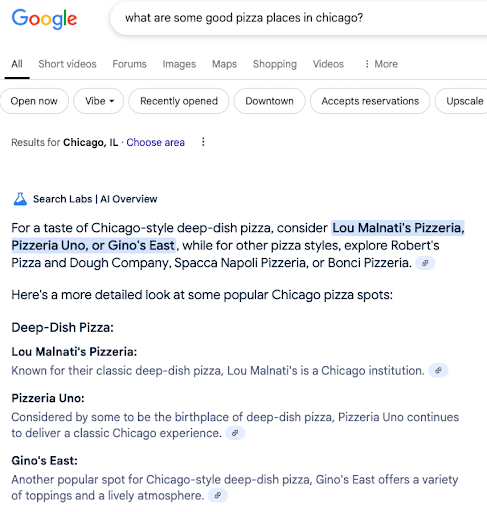
Optimize for Voice Search
Voice search is becoming increasingly popular and convenient as people can simply ask Siri or other AI assistants to conduct searches for them.
This dependence on voice search tech is why it’s important to know how to rank for “near me” keywords using more natural language.
For example, in addition to “best chinese restaurant near me,” you might want to include more conversational terms like “what are the best chinese places near me” or “where can i get a late-night chinese order.”
Keep in mind that optimizing for voice search can also help appeal to AI-powered searches.
Step 3: Optimize On-Page SEO
To connect with people who are searching “near me” keywords in your locations, here are some best practices for on-page SEO for multiple locations.
Optimize Title Tags
Title tags are the clickable lines of text people see in Google search results. Optimize these with your locations to help them achieve SEO “near me” rankings, along with other relevant terms.
Write Meta Descriptions
Below the title tags are meta descriptions, which should encourage users to click the title tag and visit your page. They won’t directly affect SEO, but they can give your pages some credibility among those searching “near me” keywords. Optimizing meta descriptions for local searches could ultimately make your website appear more legitimate, attracting more clicks.

Use Keywords in Header Tags
In addition to the metadata that appears in search results, incorporate local keyword optimization into your pages’ headers, from the H1 that serves as the title of your page to H2 subheaders, H3s, and so on down the hierarchy.
For instance, as you go down a location page, you might modify your services with locally targeted keywords in each subsection discussing a service. For instance, a landscaper might have sections such as “Lawnmowing Services Near Me in [City]” and “Culvert Installation Near Me in [City].”
Adhere to EEAT Guidelines
One major way to help optimize for local SEO “near me” terms is to ensure your content demonstrates experience, expertise, authoritativeness, and trustworthiness (EEAT). These aspects signal to Google that people like your content and find it helpful as an authoritative source of information.
Build Internal Links
To further optimize SEO for multiple locations on your site, link to various pages from others on your site. High-ranking, valuable pages linking to others can serve as supports for those linked pages.
Use Geocode Images and Alt Text
Another way to outrank competitors with local search optimization is to geocode images. This practice allows you to associate images with your business location. Try one of the following ways:
- Use a photo-sharing app like Flickr. You simply upload images and geocode them with the location. Then, link back to your website from the Flickr description.
- Take pictures with a GPS-enabled camera. Doing so stores the geo-coordinates of the photo in the image EXIF (exchangeable image file format). Since it’s part of the metadata, uploading it to a photo-sharing site allows it to read this. It can be a good time saver for bulk uploads.
- Rely on schema markup. In this case, you’ll use the ImageObject markup. Whenever you add an image to your site, create more details about it with that markup. Be sure to enable the ContentLocation attribute to specify the location. Google will be more likely to recognize you in location-based searches with this workflow.
Include Schema Markup
Another big factor to think about for multi-location SEO is schema markup, or structured data.
According to Google, structured data offers “a standardized format for providing information about a page and classifying the page content.” Adding Local Business Schema allows you to provide the search engine with more information about your website.
Google offers several options for making your website, content, and location information available for search results, Google Maps listings, and Knowledge Panel. Before you can start marking up the page, make sure that your Google Business Profile and Google Search Console accounts are set up and verified.
From there, you’ll want to add in the “basics” including:
- Business Contact Markup
- Site Logo
- Social Profiles
Make Your Website Responsive & User Friendly
One of the reasons that “near me” SEO searches have kicked up so much recently is because of mobile technology. People on the go just whip out their smartphones and perform searches like “restaurants near me.”
Mobile is now the leading device for Google searches at 63%. Further, Google confirmed that it transitioned to mobile-first indexing in October 2023.
Be sure to implement the following mobile-first best practices:
- Simplify navigation to make it intuitive.
- Embrace white space to avoid overwhelming pages of images and text.
- Employ mobile-first design techniques that account for micro-interactions, user flows, and checkout to eliminate friction.
- Design for taps and swipes, not mouse clicks. Buttons and navigation must be thumb-friendly.
- Make layouts adaptable by default rather than fixed for consistent user experiences across devices and browsers.
- Make typography responsive with em units for font sizes.
- Hide elements not needed for the mobile experience and leverage conditional loading so they don’t bog down the loading speed
- Export all resolutions of images for each device type.
- Optimize your site for stickiness, meaning visitors will stay a while and not bounce. Content should be compelling and relevant and nudge people toward a conversion. Use powerful and engaging words and make alterations to the sentence structure. To do it quickly and efficiently, a paraphrasing tool can be a good option.
Streamline Site Navigation
Site navigation allows you to highlight different sections of your site—and takes up more real estate in the SERPs than your average listing.
For multi-location businesses, site navigation is a great way to ensure searchers find the right location without having to explore the entire sitemap.
Include Driving Directions
Most of us don’t need directions anymore, as we rely on GPS technology. Search bots, however, find them important.
On your contact or location pages, add directions with several options, depending on where the person may be driving from. It’s another clue for Google to consume about your location and improve your local SEO strategy.

Create Hyper-Local Content
In learning how to rank for “near me” searches, another critical step for on-page SEO is to develop hyper-local content that appeals to your target audiences in each location.
Don’t simply attempt to target local SEO “near me” terms—show that you understand the different aspects of each community, with content around specific community events, directions helping people find you based on familiar landmarks, and other elements that could increase prominence in each area.
Utilize User-Generated Content (UGC)
In optimizing your content, don’t neglect to use user-generated content that your customers can produce and which you can repurpose for marketing materials.
Encourage your customers to leave reviews on Google and other platforms, provide more in-depth testimonials to feature on your website, and upload photos demonstrating your products or services. In learning how to rank for “near me” keywords with UGC, you can take steps like optimizing images with local keywords that your customers provided via social media or other platforms, using these content pieces to connect with local communities more effectively.
To make the implementation of UGC even easier and automated, consider using widgets and embedding Google reviews on your website and other platforms. For instance, you could use the Tagbox WordPress plugin to create UGC galleries on your website.
Step 4: Incorporate Off-Page SEO
Multi-location SEO will also need certain off-page elements, including:
List Local Events
Another way to signal to Google that you’re in the neighborhood is to include local events you sponsor on your website. Schema markup, once again, is your ally here.
With the Event markup, you’ll tell the search engine the details. They’ll also need to be part of that website page for visitors. Location attribution in the markup is vital here to support local search SEO.
Here’s a quick example.
You sponsor an annual craft market in your city that features local artisans. You’ll optimize the Event markup schema using the location attribute. On your website, you’ll add more information about what it is, where it is, your sponsorship, and other descriptors.
By searching “craft fair near me,” these are the local results.

Build Your Backlink Profile
Building a healthy backlink profile is essential for SEO. A SEMRush study found that 92.3% of the top-ranking domains for a term had these. These act as a referrer, which Google likens to credibility. You can have a clear advantage over competitors with this plan, as most pages have zero backlinks, according to Backlinko.
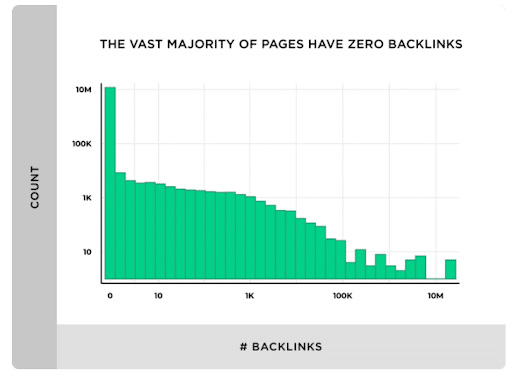
In the context of local SEO “near me” searches, you want to focus on geographic anchor text, which could include your business city and state.
For example: “Advantage Dental Services in Kalamazoo, Michigan.” Leveraging this is one more way Google identifies your business location.
Before you try these strategies out, use these link-building strategies:
- Niche-relevant backlinks help search engines understand your website’s context better, improving the indexing and ranking of your web pages.
- When gaining high authority links, identify a keyword with decent search volume. This keyword research is a critical first step in the process.
- Local media and community resource websites are a good place to start for backlinks. Many organizations have sections on their websites dedicated to giving local businesses more visibility.
- When aiming to generate backlinks, remember it’s about the quality, not just quantity. Google considers the quality of your backlinks in their SEO algorithm, not how many.
- Always stick to proper SEO by following search engine guidelines. Get creative with strategies like guest posting, infographics, and producing high-quality content that others want to link to.
When you engage in outreach to connect with potential partners, there are plenty of templates you can use to help you simplify the process, especially when reaching out to multiple local sources at once.
For instance, you could use a template that offers a friendly greeting, with placeholders for the recipient’s name and the sender’s name and occupation within your company. However, outreach should be unique enough to come off as genuine as you attempt to build a partnership, mentioning specific aspects of the recipient’s website and content.
There are also many types of local partnerships you can develop for link building purposes, such as:
- Guest post opportunities, in which you could submit a locally relevant post on a blogger’s or publication’s website in exchange for a link back to your site
- Link exchanges across different types of content
- Co-hosting online events like networking events, seminars, and workshops, with the ability to promote the event and include optimized backlinks in the process
- Cross-promotions with local businesses who aren’t competitors, linking to each other’s websites within those promotions
- Collaborating on infographics, articles, or other content that you can use to target the same local audiences
Include Your NAP Everywhere
Local SEO NAP (name, address, phone number) describes putting these descriptors throughout your website. Doing so delivers more information to search engines, improving your local SEO “near me” rankings.
You’ll want to use Schema Markup, specifically the LocalBusiness markup. Another pro tip is to be consistent in how you present your address. It should be the same across all digital spaces.
Manage Online Reviews and Reputation
It’s also important to encourage and curate reviews for your website to bolster your local SEO strategy, whether your reviews appear on Google Reviews, Yelp, or other platforms. More positive reviews means more trust, and Google will also be more encouraged to rank you over low-ranking competitors.
While you can’t get rid of reviews for simply being negative, you can always respond to bad reviews with a thoughtful reply and explanation, which could go a long way in building more trust and maintaining a good reputation.
“Near Me” Terms for Franchise and Multi-Location Businesses
When it comes to multi-location and franchise business marketing, targeting SEO “near me” keywords is essential for all locations.
Every location must connect with high-intent prospects, making it crucial to know how to rank website proximity all over a city to drive more traffic. To effectively connect with all local audiences with content, “near me” keywords should appear throughout well-optimized geo pages that speak to each community.
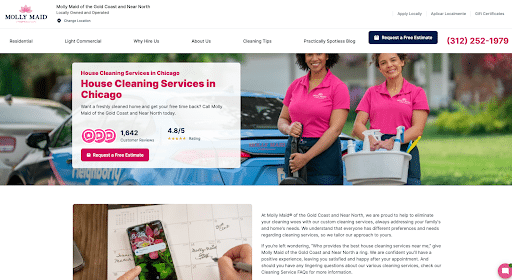
Each geo page could incorporate locally relevant content discussing local neighborhoods and even landmarks, with directions and an embedded map for even more effective local search marketing.
Also, make sure each geo page includes a convenient call to action that moves people down the sales funnel. For example, throughout the above example, Molly Maid includes multiple “Request a Free Estimate” buttons without obstructing the user experience.
AI and Local SEO: The Future of Search
One of the greatest innovations in local search marketing today is AI, which can help optimize content for “near me” and many other locally targeted terms.
Using AI and machine learning, you can optimize your content more effectively to speak to local audiences.
For example, AI marketing analytics tools can analyze consumer behavior to detect patterns and anticipate future behavior and trends. Predictive analytics could then help you steer your content in the right direction to continually connect with audiences at every touchpoint along the customer journey.
Additionally, AI could help you optimize your geo pages and other SEO “near me” content by enabling more in-depth keyword research, tracking local ranking signals, and giving insights into performance as well as guidance on how to further improve content for better rankings.
Need help getting your franchise brand featured in AI overviews? Learn more about our GEO Services.
Meanwhile, dynamic ad content and other types of personalized marketing materials could benefit from AI optimization, reengineering your content to speak more directly to your audiences.
AI can also assist with detecting critical errors in technical SEO that might otherwise negatively affect your pages’ performance, detailing the steps you can take to keep your site functioning the way it should.
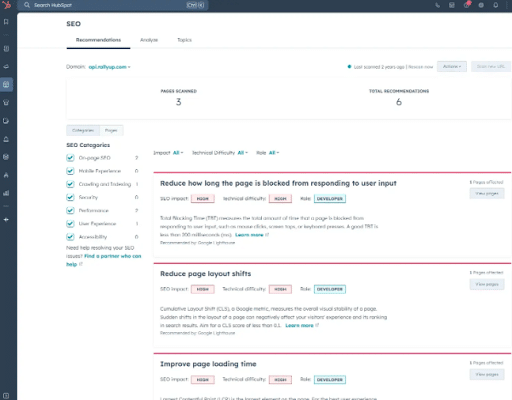
Tracking and Measuring Local SEO Performance
To further ensure you rank for local SEO “near me” results, you need to consistently monitor and measure your local SEO strategy.
There are plenty of metrics and key performance indicators you can track based on the goals you set for your campaigns, such as:
- Website traffic
- Keyword rankings
- Competitor rankings
- Social media engagement (likes, shares, and comments)
- Conversion rate
- Click-through rate
There are also plenty of tools that can help you track these and other metrics. Two primary platforms include Google Search Console and Google Business Profile Insights.
In addition, you might use tools like Facebook, Instagram, or other social media insights. Meanwhile, platforms like Semrush can give you even more insight into your website’s local performance.
Common Mistakes to Avoid With Local SEO “Near Me” Optimization
When discovering how to rank for “near me” keywords and other local terms, here are some critical mistakes to avert with your strategy:
Keyword Stuffing
One of the biggest mistakes you can make today is to simply stuff your content with keywords in ways that feel unnatural and ruin the flow of your content. This black-hat technique was once acceptable, but today it’s a good way to not only disengage audiences but also get a penalty from Google for spammy practices.
Do This Instead
Try to find natural ways to incorporate your keywords into your content. In many cases, writing a large amount of high-quality, original content will lead you to organically include various short- and long-tail keyword instances in your content, helping optimize without overdoing it.
Inconsistent NAP
Another key mistake to avoid is making your name, address, and phone number inconsistent across your directory listings and local GBP profiles. This error can make Google uncertain of which information is correct while also confusing your potential customers.
Do This Instead
If you make any changes to your business name, address, or phone number, make sure all directories communicate that change accordingly. Using solutions like BrightLocal can help you manage all of these directory listings and align them with the correct information.
Ignoring Mobile Users
So many local searches for businesses occur on mobile devices, which is why you need to appeal to these users in addition to desktop audiences. If a website isn’t mobile-responsive, the customer experience is likely to suffer due to improper formatting and layouts, which can easily turn away customers.
Do This Instead
Develop mobile-friendly websites and mobile SEO strategies that connect with these audiences, taking full advantage of responsive design and helping mobile users find precisely what they need to make a buying decision.
Neglecting to Develop and Optimize a GBP
Another area where local SEO campaigns suffer is the absence of a Google Business Profile or the failure to fully optimize existing ones. These SERP features are among the most important for local businesses to have to maximize their visibility.
Do This Instead
Take the time to put together a comprehensive GBP, and take steps to help it thrive, such as including all relevant details like your services or product categories, writing Google Posts, and optimizing images with local keywords in captions.
FAQs:
1. What percentage of Google searches are local?
The official percentage, according to Google, hovers between 30%-50% of all searches, with the overall number on the rise as more people enter local search terms on various platforms. Knowing how to rank for the words “near me” and other local terms could help you appear for these.
2. What types of businesses will benefit from a “near me” SEO strategy?
Local SEO offers a great opportunity for businesses that interface directly with customers, clients, or patients in person. If your business has a physical location that you want people to visit, targeting local “near me” searches will help. You may benefit from SEO services for “near me” strategies.
3. What are some stats about “near me” searches?
- 98% of consumers used the Internet to find information about local businesses in 2022, up 8% from the year prior.
- 42% of millennials who perform a local search will visit a business most of the time.
- Local and organic searches account for 69% of overall digital traffic.
- 80% is the average conversion rate of local searches.
4. How do “near me” searches work?
Users enter a query for a type of business with “near me.” Based on Google’s ranking criteria and the location of the business, people see the most relevant results. Optimizing your Google Business profile and website with the tips above can improve your place.
5. How can you improve a business’s visibility to people located near you geographically?
The three pillars to making sure your business is visible to people located near you geographically are to make sure the following three things are clear and up to date:
1. Your phone number
2. Address
3. Business Hours
6. Why are “near me” searches important for businesses?
Ranking well for “near me” searches capitalizes on the search trend. These searchers often have high buying intent and are ready to buy on the go.. Being a top result increases the chance that people will be more likely to visit your business, go to your website, or contact you by phone.
7. How often should a business update its Google Business Profile for optimum local SEO?
Your profile is your business’s digital storefront. When you update depends on changes you make to operations, new products or service offerings, expanding into additional locations, or anything else major. You can also use Google Business to create posts that are visible in the Knowledge Panel. Adding new images keeps it fresh, as well.
8. How do I measure the success of my “near me” SEO strategy?
These metrics are a good start for performance:
-
- Website views from organic keyword terms.
- Google Business Profile Insights offers data on how your profile is performing relating to actions people take.
- “Near me” keyword rankings improvements, which you can measure with SEO tools.
- Mobile traffic numbers provide information on the engagement of your mobile site.
9. How has the January 2025 Google local ranking algorithm update affected “near me” searches?
With a recent update in January 2025 to Google’s local ranking algorithm, local SEO “near me” optimization requires certain key steps to maintain rankings, including:
-
- Consistent Name, Address, and Phone Number data on Google Business Profiles and all other listings
- High-quality and plenty of customer reviews and ratings that establish local credibility
- AI integrations that appeal more closely to local user intent
10. Why aren’t my “near me” rankings improving?
There are potentially many reasons why you might be struggling to rank for “near me” keywords, including stiff competition, a lack of local SEO content, the absence of a Google Business Profile and other listings, and more. An SEO service for “near me” optimization could help with this.
11. How does Google determine proximity?
Google determines the proximity of local audiences to businesses based on several factors, including the user’s location when enables, the local keywords used in the search term, and geofencing based on where the user is in relation to the business.
12. Should I get local SEO services for “near me” strategies?
If you’re searching for “SEO services near me,” a company like Ignite Visibility can help you get what you need for a comprehensive strategy, helping you figure out how to rank for the words “near me” and many other relevant local keywords. You can then focus on growing your business.
Start Ranking Higher in Local SEO “Near Me” Searches
Hundreds of services utilize local search tactics to improve their traffic. It can be challenging to manage for any business, but we can help. Our local SEO experts and proven strategies help organizations improve their rankings and convert more customers.
Looking for “SEO services near me?” Maybe you’re specifically seeking “local SEO services near me” that can help you reach the right local audiences at the right time. Whether you’re looking for a few quick wins or building up your local search strategy, Ignite Visibility can help you:
- Increase your local traffic
- Boost overall sales
- Build a stronger backlink profile
- And more
Ready to test out some of these strategies? Contact us now to get started.


